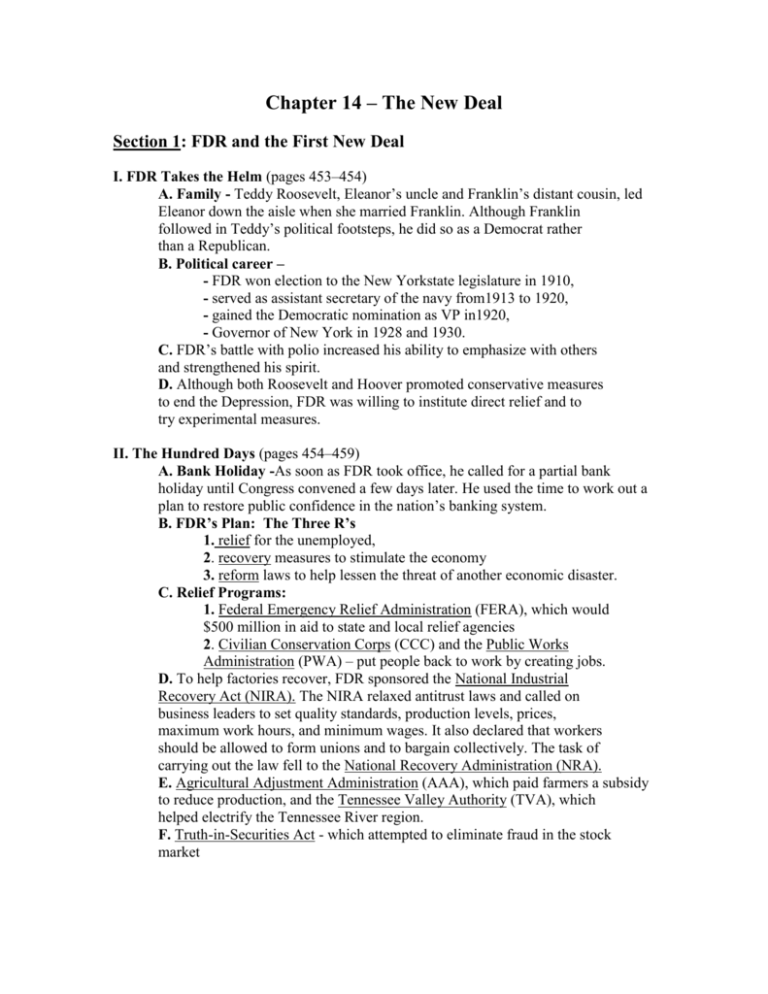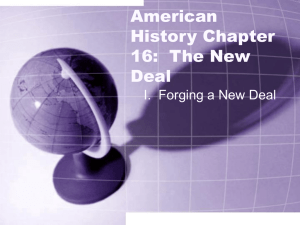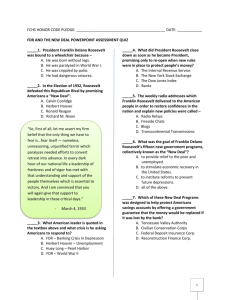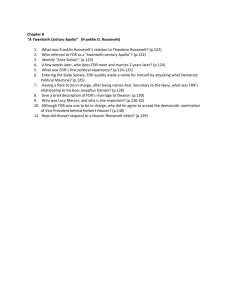Chapter 14 – The New Deal
advertisement

Chapter 14 – The New Deal Section 1: FDR and the First New Deal I. FDR Takes the Helm (pages 453–454) A. Family - Teddy Roosevelt, Eleanor’s uncle and Franklin’s distant cousin, led Eleanor down the aisle when she married Franklin. Although Franklin followed in Teddy’s political footsteps, he did so as a Democrat rather than a Republican. B. Political career – - FDR won election to the New Yorkstate legislature in 1910, - served as assistant secretary of the navy from1913 to 1920, - gained the Democratic nomination as VP in1920, - Governor of New York in 1928 and 1930. C. FDR’s battle with polio increased his ability to emphasize with others and strengthened his spirit. D. Although both Roosevelt and Hoover promoted conservative measures to end the Depression, FDR was willing to institute direct relief and to try experimental measures. II. The Hundred Days (pages 454–459) A. Bank Holiday -As soon as FDR took office, he called for a partial bank holiday until Congress convened a few days later. He used the time to work out a plan to restore public confidence in the nation’s banking system. B. FDR’s Plan: The Three R’s 1. relief for the unemployed, 2. recovery measures to stimulate the economy 3. reform laws to help lessen the threat of another economic disaster. C. Relief Programs: 1. Federal Emergency Relief Administration (FERA), which would $500 million in aid to state and local relief agencies 2. Civilian Conservation Corps (CCC) and the Public Works Administration (PWA) – put people back to work by creating jobs. D. To help factories recover, FDR sponsored the National Industrial Recovery Act (NIRA). The NIRA relaxed antitrust laws and called on business leaders to set quality standards, production levels, prices, maximum work hours, and minimum wages. It also declared that workers should be allowed to form unions and to bargain collectively. The task of carrying out the law fell to the National Recovery Administration (NRA). E. Agricultural Adjustment Administration (AAA), which paid farmers a subsidy to reduce production, and the Tennessee Valley Authority (TVA), which helped electrify the Tennessee River region. F. Truth-in-Securities Act - which attempted to eliminate fraud in the stock market G. Glass-Steagall Banking Act - which banned banks from investing savings deposits in the stock market. The Glass-Steagall Act also established the Federal Deposit Insurance Commission (FDIC) to insure bank deposits in member banks. H. During the Hundred Days between March 9 and June 16, FDR proposed 15 bills that came to be collectively known as the First New Deal. A Congress controlled by Democrats passed all 15 with only minor changes. III. The President and the People (pages 459–460) A. FDR used frequent radio broadcasts known as fireside chats to promote his programs and to inspire confidence in the people. He also held weekly press conferences that made him popular with reporters. B. Eleanor Roosevelt first became involved in politics during her husband’s battle with polio. She rallied public support for the New Deal through lecture tours, personal travels, attention to correspondence, and her own regular press conferences. Section 2: Criticism and Reformulation I. New Deal: Opposition and Problems A. Although the nation had begun to recover under the New Deal, the recovery was incomplete: 1. Incomes and farm prices still lagged behind precrash levels. 2. In addition, more than 20 percent of the working population was still unemployed. The AAA did some farmers more harm that good. Landowners tended to reduce the number of acres planted by evicting tenant farmers and keeping AAA subsidies for themselves. 3. The interracial Southern Tenant Farmers’ Union (STFU) tried to win a fair share of the subsidies, but it met strong opposition from landowners and inaction by Roosevelt. 4. The NIRA helped spur unionization but did little to ease conflicts between workers and management. Because unionization tended to increase the number of strikes and protests, many business leaders and factory owners illegally tried to prevent unionizing. **Roosevelt, who worried about labor’s power to halt economy recovery, did not actively protect workers’ rights. B. Frustrated with the slowness and the limited scope of Roosevelt’s New Deal, many Americans turned to leaders who promised simple and sometimes radical solutions to the nation’s pressing problems. C. Popular New Deal opponents included: 1. Dr. Francis Townshend, who proposed retirement and a government pension for everyone over age 60, 2. Father Charles Coughlin, a demagogue whose anti-Semitic tirades called for a redistribution of wealth, 3. Louisiana Senator Huey Long, who launched his own Share the Wealth campaign. II. New Deal: No Deal! (pages 468–469) A. Roosevelt not only faced opposition from people who demanded that the government do more for the needy, but also from people who demanded it do less. B. Many business leaders charged that Roosevelt was: 1. interfering too much with private businesses, 2. spending an excessive amount of money on relief, 3. leading the nation toward socialism. C. In 1934 a number of unhappy politicians and businesspeople formed the American Liberty League to destroy the New Deal (never gained much support) D. The Supreme Court - had more success than millionaires in attacking the New Deal. In the mid-1930s the Court overturned the NIRA on the grounds that it gave too much power to the executive branch. It also objected to the AAA, saying that the government could not use a processing tax to regulate agricultural production. This tax had been used to fund AAA subsidies. E. Faced with attacks by radicals, liberals, and conservatives and hampered by the Supreme Court, FDR revamped his recovery and reform policies. In 1935 he launched the Second New Deal. III. The Second New Deal (pages 469–471) ** In 1935 he launched the Second New Deal. A. Works Progress Administration - To put more people back to work, FDR proposed the WPA in April 1935. The WPA, headed by Harry Hopkins, funded a variety of building projects and put unemployed artists, teachers, writers, and actors back to work. B. Social Security Act – Passed by Congress in August 1935, it instituted pensions and survivors’ benefits for the elderly and the orphaned and aid to individuals injured in industrial accidents. C. Roosevelt further aided recovery by restoring to workers and farmers the rights and privileges that the Supreme Court had revoked. D. The Wagner Act of 1935 restored the right of workers to form unions and to bargain collectively. It also set up the National Labor Relations Board (NLRB) to ensure that employers followed the new law. E. The Soil Conservation Act - 1936 required farmers to reduce the acreage of the same crops the AAA had previously paid them not to plant. F. To further help farmers, Congress passed the Rural Electrification Act of 1935, which lent money to groups of farmers who organized to build power plants. G. Roosevelt won widespread popular support with passage of the Public Utility Holding Company Act, which pared down huge utility conglomerates, and the Revenue Act of 1935, which increased the taxes paid by wealthy corporations and individuals. Section 3: The Impact of the New Deal I. Women Gain Political Recognition (pages 477–478) A. Eleanor Roosevelt - used her position as First Lady to publicly support women through such activities as her women-only press conferences. She also worked behind the scenes to pressure FDR to expand the role of women in government. B. Government positions - In all, more than 100 women held senior positions in the federal government during FDR’s administration. They included Secretary of Labor Frances Perkins, the first woman to hold a cabinet post. C. Discrimination – Although Roosevelt supported women’s rights, he tended to appoint women to government posts where they would be least likely to conflict with men. Therefore, women in government lacked the clout to offset the lower wages and unfair hiring practices endured by women—some of which were enshrined in NRA codes. II. African Americans Gain a Voice (pages 478–479) A. Although most African Americans in the Roosevelt administration were appointed to secondary posts, they nevertheless exerted influence collectively as the black cabinet. The group of about 50 African American appointees included Mary McLeod Bethune, head of the Negro Affairs Division of the National Youth Administration. B. Under Secretary of the Interior Harold Ickes, the PWA allocated funds for the construction of African American hospitals, universities, and housing projects. PWA building contracts also contained a clause requiring the number of African Americans hired be at least equal in proportion to their number in the local population—a practice that became the basis for later civil rights legislation. C. Roosevelt sidestepped a number of racial issues fearing a white backlash,. He did little to eliminate discrimination in the work place. He also failed to push for a federal anti-lynching law and left poll taxes in place throughout the South. III. Native Americans Gain an Ally (pages 479–480) A. Indian Reorganization Act of 1934, which helped promote Native American cultures and preserve tribal ownership of reservation lands. B. With the Indian Reorganization Act, Native Americans gained control of their reservations and could decide how their lands would be used and managed. The act also encouraged Native Americans to establish their own governments on reservations, which could then apply for funds from the Indian Bureau. IV. An Expanded Government Role (pages 480-481) A. By including the excluded—women, African Americans, Native Americans, farmers, common laborers, the poor—the New Deal brought government closer to all the people. B. During the Roosevelt administration, 14 percent of all families obtained aid or relief from the federal government. C. Federal regulation, or the expansion of the federal government into almost all aspects of people’s lives, was a direct legacy of the New Deal. Under the New Deal, the federal government assumed responsibility for the economic welfare of individuals as well as for the health of the nation’s economy at large. D. Although the New Deal generally increased people’s confidence in the nation’s political and economic systems, it neither eliminated individual poverty nor ended the Depression. Complete recovery did not come until World War II was well under way.








